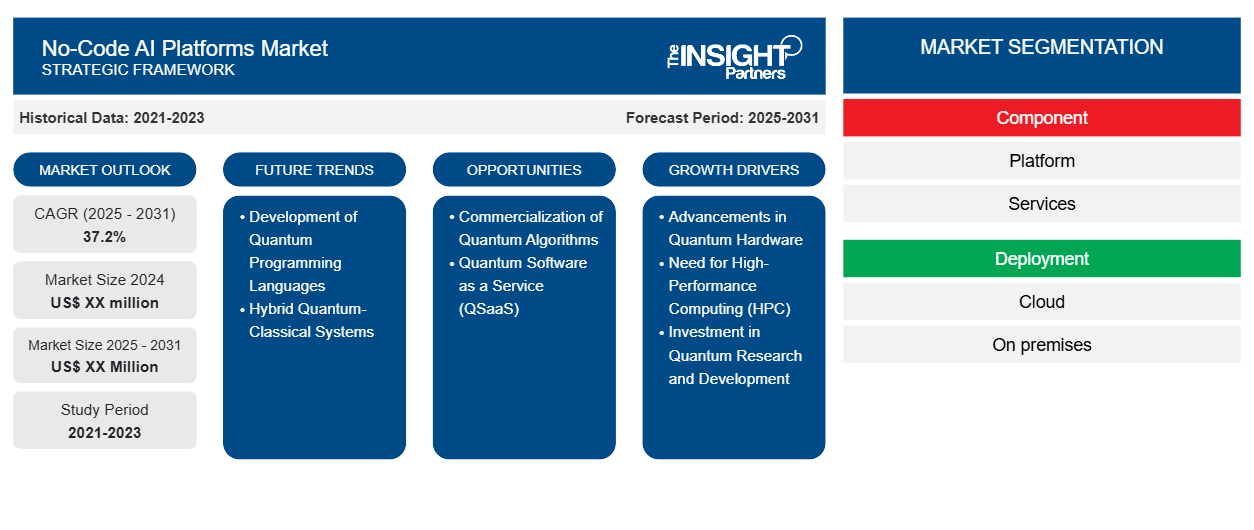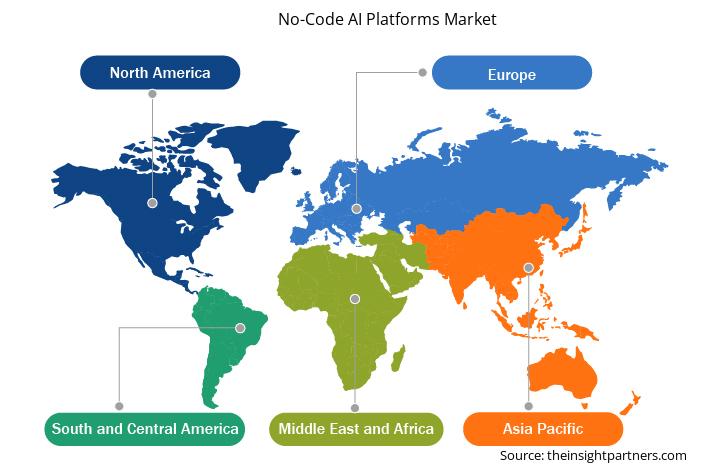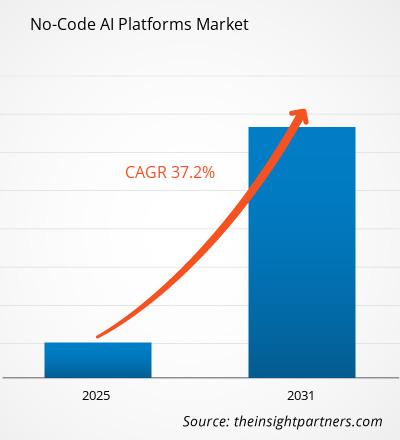Der Markt für No-Code-KI-Plattformen wird voraussichtlich zwischen 2025 und 2031 eine durchschnittliche jährliche Wachstumsrate (CAGR) von 37,2 % verzeichnen, wobei die Marktgröße von XX Millionen US-Dollar im Jahr 2024 auf XX Millionen US-Dollar im Jahr 2031 anwachsen wird.
Der Bericht ist segmentiert nach Komponenten (Plattform, Dienste); Bereitstellung (Cloud, On-Premises); Unternehmensgröße (Großunternehmen, KMU); Endnutzer (IT und Telekommunikation, Gesundheitswesen, Fertigung, Einzelhandel und E-Commerce, Behörden, BFSI, Sonstige). Die globale Analyse wird weiter nach Regionen und wichtigen Ländern aufgeschlüsselt. Der Bericht bietet den Wert in USD für die oben genannten Analysen und Segmente.
Zweck des Berichts
Der Bericht „No-Code-KI-Plattformen Markt“ von The Insight Partners beschreibt die aktuelle Situation und das zukünftige Wachstum sowie die wichtigsten Treiber, Herausforderungen und Chancen. Dies bietet verschiedenen Geschäftsbereichen Einblicke, beispielsweise:
- Technologieanbieter/-hersteller: Um die sich entwickelnde Marktdynamik zu verstehen und die potenziellen Wachstumschancen zu kennen, können sie fundierte strategische Entscheidungen treffen.
- Investoren: Um eine umfassende Trendanalyse hinsichtlich der Marktwachstumsrate, der finanziellen Marktprognosen und der Chancen entlang der Wertschöpfungskette durchzuführen.
- Regulierungsbehörden: Sie regulieren die Richtlinien und polizeilichen Aktivitäten auf dem Markt mit dem Ziel, Missbrauch zu minimieren, das Vertrauen der Anleger zu wahren und die Integrität und Stabilität des Marktes aufrechtzuerhalten.
Marktsegmentierung für No-Code-KI-Plattformen
Komponente
- Plattform
- Leistungen
Einsatz
- Wolke
- Vor Ort
Unternehmensgröße
- Große Unternehmen
- KMU
Endbenutzer
- IT und Telekommunikation
- Gesundheitspflege
- Herstellung
- Einzelhandel und E-Commerce
- Regierung
- BFSI
Passen Sie diesen Bericht Ihren Anforderungen an
Sie erhalten kostenlos Anpassungen an jedem Bericht, einschließlich Teilen dieses Berichts oder einer Analyse auf Länderebene, eines Excel-Datenpakets sowie tolle Angebote und Rabatte für Start-ups und Universitäten
Markt für No-Code-KI-Plattformen: Strategische Einblicke

-
Informieren Sie sich über die wichtigsten Markttrends in diesem Bericht.Dieses KOSTENLOSE Beispiel umfasst Datenanalysen, von Markttrends bis hin zu Schätzungen und Prognosen.
Marktwachstumstreiber für No-Code-KI-Plattformen
-
Fortschritte bei Quantenhardware
Die rasante Entwicklung von Quantenhardware hat dem Markt für Quantencomputersoftware deutlichen Auftrieb gegeben. Mit zunehmender Leistung und Stabilität von Quantenprozessoren wächst der Bedarf an anspruchsvoller Software, um ihr Potenzial auszuschöpfen. Unternehmen investieren zunehmend in Software, die auf Quantensystemen operieren kann. Dies treibt Innovationen bei Algorithmen, Fehlerkorrektur und Rechentechniken voran und steigert die Nachfrage nach Quantensoftwarelösungen. - Bedarf an High-Performance Computing (HPC): Quantencomputing verspricht die Lösung komplexer Probleme, die herkömmliche Computer nicht effizient bewältigen können, wie etwa Optimierung, Kryptografie und Arzneimittelforschung. Branchen wie Pharma, Finanzen und Logistik suchen nach High-Performance-Computing-Lösungen (HPC), um diese Herausforderungen zu meistern. Die steigende Nachfrage nach HPC treibt die Einführung von Quantencomputing-Software voran, die Durchbrüche in diesen Bereichen ermöglichen kann.
- Investitionen in Quantenforschung und -entwicklung: Regierungen und Unternehmen des privaten Sektors investieren erheblich in Quantenforschung und -entwicklung, da sie das transformative Potenzial der Quantentechnologien erkennen. Dieser Anstieg der Finanzierung beschleunigt die Entwicklung von Quantenalgorithmen, Softwaretools und Frameworks und treibt damit das Wachstum des Marktes für Quantencomputersoftware voran, da Unternehmen und Forscher diese neuen Innovationen nutzen.
Markttrends für No-Code-KI-Plattformen
- Entwicklung von Quantenprogrammiersprachen: Mit der zunehmenden Verbreitung von Quantencomputing gibt es einen wachsenden Trend zur Entwicklung spezialisierter, auf Quantensysteme zugeschnittener Programmiersprachen wie Qiskit, Cirq und Quipper. Diese Sprachen sollen die Lücke zwischen Quantenhardware und Entwicklern schließen und so das Schreiben und Bereitstellen von Quantenanwendungen erleichtern. Dieser Trend treibt den Ausbau des Quantencomputing-Software-Ökosystems voran und verbessert die Zugänglichkeit und Akzeptanz.
- Hybride Quanten-Klassische Systeme: Anstatt klassische Computersysteme vollständig zu ersetzen, werden viele Quantencomputing-Anwendungen in Hybridsystemen entwickelt, die klassische und Quantenressourcen kombinieren. Dieser Trend hilft Unternehmen, die Leistungsfähigkeit des Quantencomputings für bestimmte Aufgaben zu nutzen und gleichzeitig für andere Aufgaben weiterhin auf klassisches Computing zu setzen. Der Aufstieg hybrider Quanten-Klassischer Systeme erweitert die Anwendungsfälle von Quantencomputing-Software und trägt zum Marktwachstum bei.
Marktchancen für No-Code-KI-Plattformen
- Kommerzialisierung von Quantenalgorithmen: Anbieter von Quantensoftware haben großes Potenzial, kommerzielle Quantenalgorithmen zur Lösung branchenspezifischer Probleme zu entwickeln. Von der Optimierung in der Logistik über die Finanzmodellierung bis hin zur Pharmaindustrie können Quantenalgorithmen einen Mehrwert bieten, indem sie schnellere und präzisere Lösungen als klassische Ansätze liefern. Da Unternehmen das kommerzielle Potenzial von Quantenalgorithmen erkennen, wird die Nachfrage nach Quantensoftware weiter steigen.
- Quantum Software as a Service (QSaaS): Das Konzept, Quantensoftwarelösungen über die Cloud anzubieten, oder Quantum Software as a Service (QSaaS), bietet große Chancen. Dieses Modell ermöglicht Unternehmen den Zugriff auf Quantencomputing-Funktionen, ohne in teure Quantenhardware investieren zu müssen. Durch den skalierbaren On-Demand-Zugriff auf Quantensoftware öffnet QSaaS Türen für kleinere Organisationen und Forschungseinrichtungen und erweitert so den Markt für Quantencomputing-Software.
Regionale Einblicke in den Markt für No-Code-KI-Plattformen
Die Analysten von Insight Partners haben die regionalen Trends und Faktoren, die den Markt für No-Code-KI-Plattformen im Prognosezeitraum beeinflussen, ausführlich erläutert. In diesem Abschnitt werden auch die Marktsegmente und die geografische Lage von No-Code-KI-Plattformen in Nordamerika, Europa, Asien-Pazifik, dem Nahen Osten und Afrika sowie Süd- und Mittelamerika erörtert.

- Holen Sie sich die regionalen spezifischen Daten für den Markt für No-Code-KI-Plattformen
Umfang des Marktberichts zu No-Code-KI-Plattformen
| Berichtsattribut | Details |
|---|---|
| Marktgröße im Jahr 2024 | XX Millionen US-Dollar |
| Marktgröße bis 2031 | XX Millionen US-Dollar |
| Globale CAGR (2025 – 2031) | 37,2 % |
| Historische Daten | 2021-2023 |
| Prognosezeitraum | 2025–2031 |
| Abgedeckte Segmente |
Nach Komponente
|
| Abgedeckte Regionen und Länder |
Nordamerika
|
| Marktführer und wichtige Unternehmensprofile |
|
Marktteilnehmerdichte für No-Code-KI-Plattformen: Auswirkungen auf die Geschäftsdynamik verstehen
Der Markt für No-Code-KI-Plattformen wächst rasant. Dies wird durch die steigende Endnutzernachfrage aufgrund veränderter Verbraucherpräferenzen, technologischer Fortschritte und eines stärkeren Bewusstseins für die Produktvorteile vorangetrieben. Mit der steigenden Nachfrage erweitern Unternehmen ihr Angebot, entwickeln Innovationen, um den Verbraucherbedürfnissen gerecht zu werden, und nutzen neue Trends, was das Marktwachstum weiter ankurbelt.
Die Marktteilnehmerdichte beschreibt die Verteilung der in einem bestimmten Markt oder einer bestimmten Branche tätigen Unternehmen. Sie gibt an, wie viele Wettbewerber (Marktteilnehmer) in einem bestimmten Marktraum im Verhältnis zu dessen Größe oder Gesamtmarktwert präsent sind.
Die wichtigsten Unternehmen, die auf dem Markt für No-Code-KI-Plattformen tätig sind, sind:
- Amazon.com. Inc.
- Microsoft
- Google LLC
- Apple Inc.
- Caspio, Inc.
- DataRobot, Inc.
Haftungsausschluss : Die oben aufgeführten Unternehmen sind nicht in einer bestimmten Reihenfolge aufgeführt.

- Überblick über die wichtigsten Akteure auf dem Markt für No-Code-KI-Plattformen
Wichtige Verkaufsargumente
- Umfassende Abdeckung: Der Bericht deckt die Analyse von Produkten, Diensten, Typen und Endbenutzern des Marktes für No-Code-KI-Plattformen umfassend ab und bietet eine ganzheitliche Landschaft.
- Expertenanalyse: Der Bericht basiert auf dem umfassenden Verständnis von Branchenexperten und Analysten.
- Aktuelle Informationen: Der Bericht gewährleistet Geschäftsrelevanz durch die Berichterstattung über aktuelle Informationen und Datentrends.
- Anpassungsoptionen: Dieser Bericht kann angepasst werden, um den spezifischen Kundenanforderungen gerecht zu werden und die Geschäftsstrategien optimal anzupassen.
Der Forschungsbericht zum Markt für No-Code-KI-Plattformen kann daher dazu beitragen, die Branchensituation und die Wachstumsaussichten zu entschlüsseln und zu verstehen. Obwohl es einige berechtigte Bedenken geben mag, überwiegen die Vorteile dieses Berichts tendenziell die Nachteile.
- Historische Analyse (2 Jahre), Basisjahr, Prognose (7 Jahre) mit CAGR
- PEST- und SWOT-Analyse
- Marktgröße Wert/Volumen – Global, Regional, Land
- Branchen- und Wettbewerbslandschaft
- Excel-Datensatz
Aktuelle Berichte
Verwandte Berichte
Erfahrungsberichte
Grund zum Kauf
- Fundierte Entscheidungsfindung
- Marktdynamik verstehen
- Wettbewerbsanalyse
- Kundeneinblicke
- Marktprognosen
- Risikominimierung
- Strategische Planung
- Investitionsbegründung
- Identifizierung neuer Märkte
- Verbesserung von Marketingstrategien
- Steigerung der Betriebseffizienz
- Anpassung an regulatorische Trends






















 Kostenlose Probe anfordern für - Markt für No-Code-KI-Plattformen
Kostenlose Probe anfordern für - Markt für No-Code-KI-Plattformen